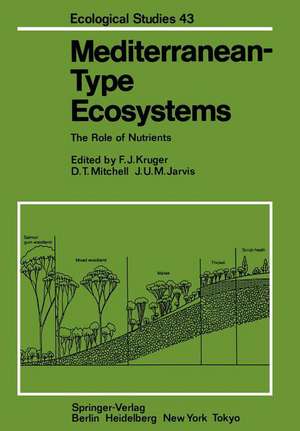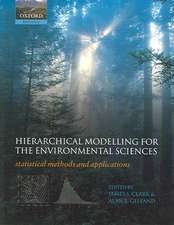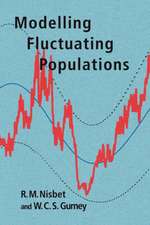Mediterranean-Type Ecosystems: The Role of Nutrients: Ecological Studies, cartea 43
Editat de F. J. Kruger, D. T. Mitchell, J. U. M. Jarvisen Limba Engleză Paperback – 7 dec 2011
Din seria Ecological Studies
- 18%
 Preț: 1118.93 lei
Preț: 1118.93 lei -
 Preț: 553.72 lei
Preț: 553.72 lei - 18%
 Preț: 1680.55 lei
Preț: 1680.55 lei - 18%
 Preț: 1003.38 lei
Preț: 1003.38 lei - 20%
 Preț: 1004.71 lei
Preț: 1004.71 lei -
 Preț: 480.62 lei
Preț: 480.62 lei - 5%
 Preț: 752.26 lei
Preț: 752.26 lei - 15%
 Preț: 643.99 lei
Preț: 643.99 lei - 15%
 Preț: 644.18 lei
Preț: 644.18 lei - 15%
 Preț: 652.49 lei
Preț: 652.49 lei - 18%
 Preț: 789.83 lei
Preț: 789.83 lei -
 Preț: 382.36 lei
Preț: 382.36 lei - 15%
 Preț: 643.48 lei
Preț: 643.48 lei - 15%
 Preț: 646.30 lei
Preț: 646.30 lei - 15%
 Preț: 634.32 lei
Preț: 634.32 lei -
 Preț: 384.86 lei
Preț: 384.86 lei - 18%
 Preț: 789.98 lei
Preț: 789.98 lei - 15%
 Preț: 645.14 lei
Preț: 645.14 lei - 15%
 Preț: 649.39 lei
Preț: 649.39 lei - 18%
 Preț: 1005.43 lei
Preț: 1005.43 lei - 18%
 Preț: 949.23 lei
Preț: 949.23 lei - 15%
 Preț: 649.54 lei
Preț: 649.54 lei - 15%
 Preț: 643.34 lei
Preț: 643.34 lei - 15%
 Preț: 649.71 lei
Preț: 649.71 lei - 15%
 Preț: 638.76 lei
Preț: 638.76 lei - 18%
 Preț: 957.62 lei
Preț: 957.62 lei - 18%
 Preț: 1235.25 lei
Preț: 1235.25 lei - 18%
 Preț: 962.18 lei
Preț: 962.18 lei - 18%
 Preț: 949.23 lei
Preț: 949.23 lei - 15%
 Preț: 660.68 lei
Preț: 660.68 lei -
 Preț: 397.76 lei
Preț: 397.76 lei - 15%
 Preț: 638.24 lei
Preț: 638.24 lei - 18%
 Preț: 942.31 lei
Preț: 942.31 lei - 18%
 Preț: 1232.57 lei
Preț: 1232.57 lei - 15%
 Preț: 651.34 lei
Preț: 651.34 lei - 18%
 Preț: 952.72 lei
Preț: 952.72 lei - 18%
 Preț: 1834.27 lei
Preț: 1834.27 lei - 18%
 Preț: 1229.10 lei
Preț: 1229.10 lei -
 Preț: 423.95 lei
Preț: 423.95 lei - 18%
 Preț: 948.92 lei
Preț: 948.92 lei
Preț: 657.73 lei
Preț vechi: 773.80 lei
-15% Nou
Puncte Express: 987
Preț estimativ în valută:
125.86€ • 137.14$ • 106.05£
125.86€ • 137.14$ • 106.05£
Carte tipărită la comandă
Livrare economică 23 aprilie-07 mai
Preluare comenzi: 021 569.72.76
Specificații
ISBN-13: 9783642689376
ISBN-10: 364268937X
Pagini: 572
Ilustrații: XIV, 556 p.
Dimensiuni: 170 x 244 x 30 mm
Greutate: 0.9 kg
Ediția:Softcover reprint of the original 1st ed. 1983
Editura: Springer Berlin, Heidelberg
Colecția Springer
Seria Ecological Studies
Locul publicării:Berlin, Heidelberg, Germany
ISBN-10: 364268937X
Pagini: 572
Ilustrații: XIV, 556 p.
Dimensiuni: 170 x 244 x 30 mm
Greutate: 0.9 kg
Ediția:Softcover reprint of the original 1st ed. 1983
Editura: Springer Berlin, Heidelberg
Colecția Springer
Seria Ecological Studies
Locul publicării:Berlin, Heidelberg, Germany
Public țintă
ResearchCuprins
Section I. Evolution and Character of Mediterranean-Type Ecosystems.- 1. The Comparative Evolution of Mediterranean-Type Ecosystems: A Southern Perspective.- 2. Mediterranean-Type Heathlands and Sclerophyllous Shrublands of the World: An Overview.- 3. Ecological Control of the Vegetation of Southwestern Australia: Moisture versus Nutrients.- 4. Influence of Nutrients on the Composition and Distribution of Plant Communities in Mediterranean-Type Ecosystems of Israel.- 5. Approaches to the Definition of Mediterranean Growth Forms.- Section II. Plant Form and Function.- 6. Carbon-Gaining Capacity and Allocation Patterns of Mediterranean-Climate Plants.- 7. Moisture Regime and Nutrient Control of Seasonal Growth in Mediterranean Ecosystems.- 8. Canopy Structure of Mediterranean-Type Shrubs in Relation to Heat and Moisture.- 9. Carbon and Nitrogen Economy of Diplacus aurantiacus, a Californian Mediterranean-Climate Drought-Deciduous Shrub.- Section III. Nutrient Cycling.- 10. Nutrient Cycling in Australian Heath and South African Fynbos.- 11. Impact of Fire on Nutrient Cycles in Mediterranean-Type Ecosystems with Reference to Chaparral.- 12. Decomposition and Mineralization Processes in Mediterranean-Type Ecosystems and in Heathlands of Similar Structure.- 13. The Effects of Different Fire Regimes on Soil Nutrient Levels in Quercus coccifera Garrigue.- Section IV. Plant Nutrition.- 14. Strategies for Maximizing Nutrient Uptake in Two Mediterranean Ecosystems of Low Nutrient Status.- 15. The Effects of Fire on Photosynthesis in Chaparral Resprouts.- 16. Mineral Nutrient and Nonstructural Carbon Pools in Shrubs from Mediterranean-Type Ecosystems of California and Chile.- 17. Comparative Phenology of Mediterranean-Type Plant Communities.- Section V. Community Patterns and Diversity.- 18. Some Thoughts on Resource Competition and Diversity in Plant Communities.- 19. On Alpha Diversity and the Richness of the Cape Flora: A Study in Southern Cape Fynbos.- 20. Continental Diversity Patterns and Convergent Evolution in Bird Communities.- 21. Distribution and Species Diversity of Birds and Plants in Fynbos Vegetation of Mediterranean-Climate Zone, South Africa.- 22. Plant Community Structure — Spatial Partitioning of Resources.- 23. Plant Community Diversity and Dynamics in Relation to Fire.- 24. Mammal Species Diversity in Australian Heathlands: the Importance of Pyric Succession and Habitat Diversity.- 25. Animal Demography in Relation to Fire and Shortage of Food: Some Indicative Models.- Section VI. Plant-Animal Interactions.- 26. The Role of Sclerophyllous Leaves in Determining Insect Grazing Damage.- 27. Defoliation Patterns in Matorral Ecosystems.















